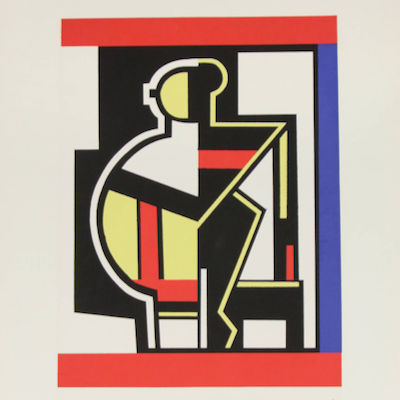
Details
Artist
Styles
Etching and aquatint in colours, on BFK Rives paper, with full margins. - This work is from the UNITÉ book, which began to be printed in 1963 and ended on October 15, 1965 in Paris. - I. 41.5 x 31.5 cm (16 3/8 x 12 3/8 in.) - S. 57 x 45.2 cm (22 1/2 x 17 3/4 in.) - Signed and numbered in pencil, from the edition of 130 pc + 30 in Roman numerals, published by Atelier Crommelynck, Paris // Le Corbusier’s Unité 15 (1963-1965) is a limited-edition etching and aquatint, printed on BFK Rives paper, showcasing his mastery of abstract and geometric forms. The composition is divided into distinct sections, each featuring swirling, tubular shapes alongside angular, block-like forms. The colors are muted but intentional, with earthy tones like beige and light blue contrasting against stronger blacks and reds. These elements appear to represent a tension between organic and constructed shapes, reflecting Le Corbusier’s ongoing exploration of how architecture and human form interact. The piece has a rhythmic quality, with repeating motifs and interlocking shapes creating a sense of flow and balance.
Unité 15, 1963-1965
form
Medium
Size
57 x 45.2 cm
- Inches
- Centimeters
Edition
Price
- USD
- EUR
- GBP
Details
Artist
Styles
Etching and aquatint in colours, on BFK Rives paper, with full margins. - This work is from the UNITÉ book, which began to be printed in 1963 and ended on October 15, 1965 in Paris. - I. 41.5 x 31.5 cm (16 3/8 x 12 3/8 in.) - S. 57 x 45.2 cm (22 1/2 x 17 3/4 in.) - Signed and numbered in pencil, from the edition of 130 pc + 30 in Roman numerals, published by Atelier Crommelynck, Paris // Le Corbusier’s Unité 15 (1963-1965) is a limited-edition etching and aquatint, printed on BFK Rives paper, showcasing his mastery of abstract and geometric forms. The composition is divided into distinct sections, each featuring swirling, tubular shapes alongside angular, block-like forms. The colors are muted but intentional, with earthy tones like beige and light blue contrasting against stronger blacks and reds. These elements appear to represent a tension between organic and constructed shapes, reflecting Le Corbusier’s ongoing exploration of how architecture and human form interact. The piece has a rhythmic quality, with repeating motifs and interlocking shapes creating a sense of flow and balance.
- Recently Added
- Price (low-high )
- Price (high-low )
- Year (low-high )
- Year (high-low )
What is Cubism?
Cubism is an art movement that aimed to depict multiple perspectives of objects or figures within a single picture. Artists Georges Braque and Pablo Picasso pioneered this style around 1907. The name Cubism emerged from their use of geometric shapes and outlines that often resembled cubes, breaking objects down into abstracted forms.


























